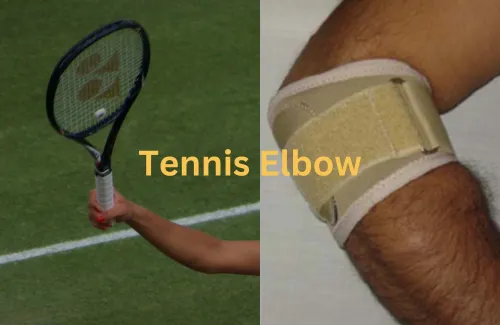Last Updated on November 3, 2023 by Robert A. Foreman
Tennis elbow, or lateral epicondylitis, is one of the most common clinical conditions caused by the irritation of forearm muscles. The patient usually feels severe pain or tenderness on the lateral aspect of the elbow joint. They also go through a hard time while gripping or carrying an object.
Now the query arises: How to tell if you have a tennis elbow? Do you need clinical assistance to confirm the tennis elbow?
Usually, an individual faces such conditions due to the vigorous movement of the arm in athletic activities. Trust me, you actually don’t need clinical assistance just to confirm it. Most of the tests can be performed at home. At a later stage, you may require a doctor’s assistance for further diagnosis.
In our content, we have highlighted all the necessary tests for a sure diagnosis of tennis elbow. We have also included exclusive tips for treating this condition, along with the most probable FAQs. So, stay with us till the end to stay safe & healthy.
Table of Contents
- Who Is Most Prone to Tennis Elbows?
- How to tell if you have a tennis elbow? different test
- 1. Palpate The Lateral Epicondyle:
- 2. Resistance Test:
- 3. The Coffee Cup Test:
- 4. Chair Pick-Up Test:
- 5. Middle finger resistance:
- 6. Mills Test:
- 7. Cozen’s Test:
- Tests For Further Investigation:
- Tennis elbow Treatment:
- FAQ:
- Does tennis elbow affect one arm or both arms?
- What are the signs and symptoms of tennis elbow?
- Will the tennis elbow fix itself?
- What string is best for tennis elbow?
- Final Words:
Who Is Most Prone to Tennis Elbows?
Tennis elbow is most common among athletes as they have to maintain a repetitive motion of the arm, elbow, wrist, or hand. Golfers, swimmers, and tennis players are highly prone to damage to the lateral epicondyle.
Non-athletic people who have to maintain a repetitive motion of the wrist in their daily activities are also at risk of lateral epicondylitis. In some rare cases, it may also develop without any concrete reason.
How to tell if you have a tennis elbow? different test
If you suspect that you have a tennis elbow, you don’t need a doctor’s assistance immediately.
There are several tests you can perform at home for a proper diagnosis of tennis elbow which include:
1. Palpate The Lateral Epicondyle:
- Extend the forearm & place it on a table.
- Try to palpate the lateral epicondyle by applying gentle pressure on it.
- Check out if there is any pain, tenderness, or swelling.
2. Resistance Test:
- Firstly, extend the affected arm in a way that the palm is directed downwards.
- Now bring the opposite hand just behind the extended hand.
- Now try to move the wrist backwards while creating resistance against the bottom hand by the extended hand.
3. The Coffee Cup Test:
This test is super easy. Just try to have a firm grip on your coffee/milk cup to measure the intensity of the pain.
4. Chair Pick-Up Test:
- Firstly get a lightweight chair with a high back.
- Extend the suspected arm and bend the wrist to grab the back of the chair.
- Use the thumb, first & middle finger to grab and lift the chair while keeping the arm straight.
5. Middle finger resistance:
- Extend the affected arm with the palm facing upwards.
- Try pulling the middle finger towards the forearm and resist this movement with the middle finger itself.
- Now turn the palm in a way that it faces downwards.
- Pull the middle finger downwards while resisting it with the middle finger like before.
6. Mills Test:
In order to perform this test, you will require a doctor’s assistance.
- Firstly the doctor will ask you to extend your arm.
- He will bend your wrist forward and will rotate the forearm in the inward direction.
- He will examine the epicondyles during this procedure.
7. Cozen’s Test:
This test is also termed the resistive tennis elbow test. This test also requires clinical assistance.
- Firstly extend & straighten the arm and make a fist.
- Turn the forearm inward while bending the wrist towards the forearm.
- Now the doctor will check the lateral epicondyle for a confirmed diagnosis.
Tests For Further Investigation:
If any of these tests indicate “positive’,” the patient needs to undergo some in-depth tests for further confirmation. These tests are essential to finding the additional causes of lateral epicondylar pain.
- The doctor will ask for an X-ray to observe the elbow joint properly. An X-ray will assist him in diagnosing other complications, such as arthritis.
- The MRI will help him observe the detailed anatomic structures.
- He may also perform electromyography (EMG) to diagnose additional nerve injuries.
Tennis elbow Treatment:

After being diagnosed as a patient with tennis elbow, the very first thing you need to do is to take a break from sporty activities that involve repetitive movements of your arms, hand, elbow, or wrist.
Later on, you can try returning to the usual schedules step by step.
- Go slow, maintain proper duration, and check how the body responds over time.
- In order to reduce pain, it’s OK to use non-steroid anti-inflammatory drugs like aspirin, naproxen, or ibuprofen.
- Try mild exercises that involve the arm, forearm, hands, wrist, & elbow. These tactics can improve the overall healing process along with flexibility and strength.
- Physical therapy
You May also check Best Cream for Tennis Elbow
FAQ:
Does tennis elbow affect one arm or both arms?
The tennis elbow usually affects the dominant side of the body. Tennis elbow can affect both arms, depending on the sort of repetitive activity you engage in.
What are the signs and symptoms of tennis elbow?
The main symptoms of the tennis elbow are – tenderness & pain around the lateral side of the elbow. The tendons of the surrounding muscles are attached to the bony knob outside the elbow. However, this pain can easily move to the arm, forearm & hand. So, although the injury is in hand, you will have a hard time grabbing, holding, or lifting objects.
Will the tennis elbow fix itself?
Yes, the tennis elbow usually gets fixed gradually without treatment. It may require around 6 months to 2 years. 90% of individuals can reach total recovery within a year. Just be sure to give proper rest to the injured arm.
What string is best for tennis elbow?
Changing the best tennis strings is the simplest and least expensive method. Some best strings for the elbow are stronger and transfer more shock to your arm, whilst others are softer and transmit far less. Softer is better for tennis elbow sufferers and is still the king when it comes to softness.
Final Words:
How to tell if you have a tennis elbow?
Even if you were confused before, I believe after going through our article you can easily diagnose if you are suffering from this condition. These tests are clinically proven, easy to try, and require minor to no medical assistance. Be aware and give proper rest to the affected area if the diagnosis result is positive. So, follow our tips to be safe, sound & healthy.

Hello, I am Robert A. Foreman founder and chief writer at Indorgames. I have had experience in Tennis for a long time since 2016. I know the exact problems that a beginner faces and know the solutions too. I have shared all my knowledge about Tennis on my website. Feel free to read them and learn more important things and facts about Tennis. follow me Twitter







